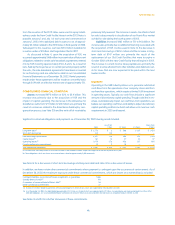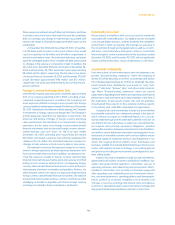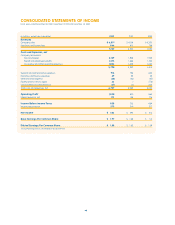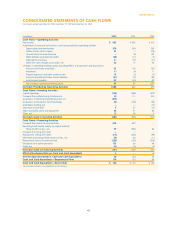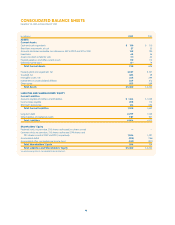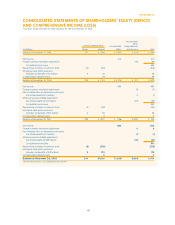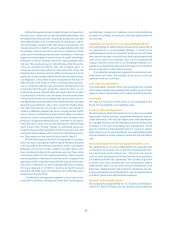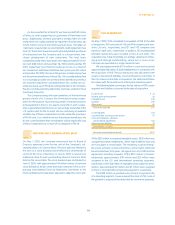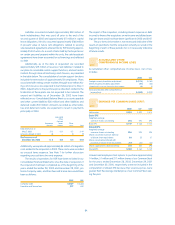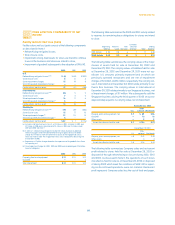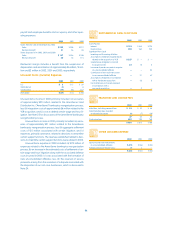Pizza Hut 2002 Annual Report Download - page 52
Download and view the complete annual report
Please find page 52 of the 2002 Pizza Hut annual report below. You can navigate through the pages in the report by either clicking on the pages listed below, or by using the keyword search tool below to find specific information within the annual report.
Refranchising gains (losses) includes the gains or losses from
the sales of our restaurants to new and existing franchisees and
the related initial franchise fees, reduced by transaction costs and
direct administrative costs of refranchising. In executing our refran-
chising initiatives, we most often offer groups of restaurants. We
classify restaurants as held for sale and suspend depreciation and
amortization when (a) we make a decision to refranchise; (b) the
stores can be immediately removed from operations; (c) we have
begun an active program to locate a buyer; (d) significant changes
to the plan of sale are not likely; and (e) the sale is probable within
one year. We recognize losses on refranchisings when the restau-
rants are classified as held for sale. We recognize gains on
restaurant refranchisings when the sale transaction closes, the
franchisee has a minimum amount of the purchase price in at-risk
equity, and we are satisfied that the franchisee can meet its finan-
cial obligations. If the criteria for gain recognition are not met, we
defer the gain to the extent we have a remaining financial expo-
sure in connection with the sales transaction. Deferred gains are
recognized when the gain recognition criteria are met or as our
financial exposure is reduced. When we make a decision to retain
a store previously held for sale, we revalue the store at the lower
of its (a) net book value at our original sale decision date less nor-
mal depreciation and amortization that would have been recorded
during the period held for sale or (b) its current fair market value.
This value becomes the store’s new cost basis. We charge (or
credit) any difference between the store’s carrying amount and its
new cost basis to refranchising gains (losses). When we make a
decision to close a store previously held for sale, we reverse any
previously recognized refranchising loss and then record impair-
ment and store closure costs as described above. Refranchising
gains (losses) also include charges for estimated exposures
related to those partial guarantees of franchisee loan pools and
contingent lease liabilities which arose from refranchising activi-
ties. These exposures are more fully discussed in Note 24.
SFAS 144 also requires the results of operations of a compo-
nent entity that is classified as held for sale or has been disposed
of be reported as discontinued operations in the Consolidated
Statements of Income if certain conditions are met. These condi-
tions include elimination of the operations and cash flows of the
component entity from the ongoing operations of the Company
and no significant continuing involvement by the Company in the
operations of the component entity after the disposal transaction.
The results of operations of stores meeting both these conditions
that were disposed of in 2002 or classified as held for sale at
December 28, 2002 were not material for any of the three years
ended December 28, 2002.
Considerable management judgment is necessary to esti-
mate future cash flows, including cash flows from continuing use,
terminal value, closure costs, sublease income, and refranchising
proceeds. Accordingly, actual results could vary significantly from
our estimates.
Impairment of Investments in Unconsolidated Affiliates
Our methodology for determining and measuring impairment of
our investments in unconsolidated affiliates is similar to the
methodology we use for our restaurants except we use cash flows
after interest and taxes instead of cash flows before interest and
taxes as we use for our restaurants. Also, we record impairment
charges related to investments in unconsolidated affiliates if cir-
cumstances indicate that a decrease in the value of an investment
has occurred which is other than temporary.
Considerable management judgment is necessary to esti-
mate future cash flows. Accordingly, actual results could vary
significantly from our estimates.
Cash and Cash Equivalents
Cash equivalents represent funds we have temporarily invested
(with original maturities not exceeding three months) as part of man-
aging our day-to-day operating cash receipts and disbursements.
Inventories
We value our inventories at the lower of cost (computed on the
first-in, first-out method) or net realizable value.
Property, Plant and Equipment
We state property, plant and equipment at cost less accumulated
depreciation and amortization, impairment writedowns and val-
uation allowances. We calculate depreciation and amortization
on a straight-line basis over the estimated useful lives of the assets
as follows: 5 to 25 years for buildings and improvements, 3 to 20
years for machinery and equipment and 3 to 7 years for capital-
ized software costs. As discussed above, we suspend depreciation
and amortization on assets related to restaurants that are held for
sale.
Internal Development Costs and Abandoned Site Costs
We capitalize direct costs associated with the site acquisition and
construction of a Company unit on that site, including direct inter-
nal payroll and payroll-related costs. Only those site-specific
costs incurred subsequent to the time that the site acquisition is
considered probable are capitalized. We consider acquisition
probable upon final site approval. If we subsequently make a
determination that a site for which internal development costs
have been capitalized will not be acquired or developed, any pre-
viously capitalized internal development costs are expensed and
included in general and administrative expenses.
Goodwill and Intangible Assets
The Company has adopted SFAS No. 141, “Business Combinations”
(“SFAS 141”). SFAS 141 requires the use of the purchase method of
50.



